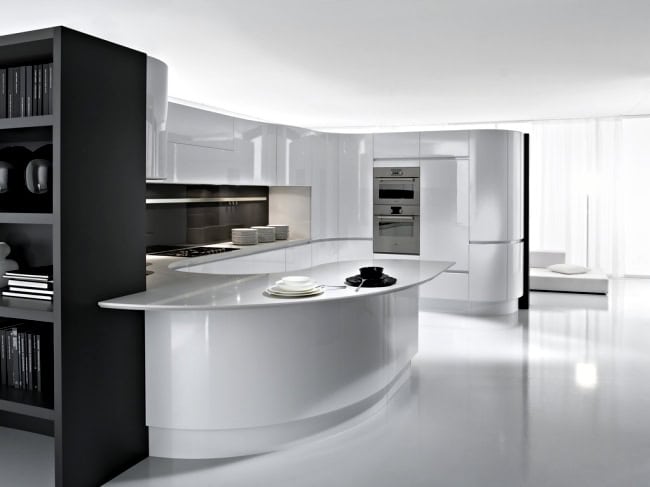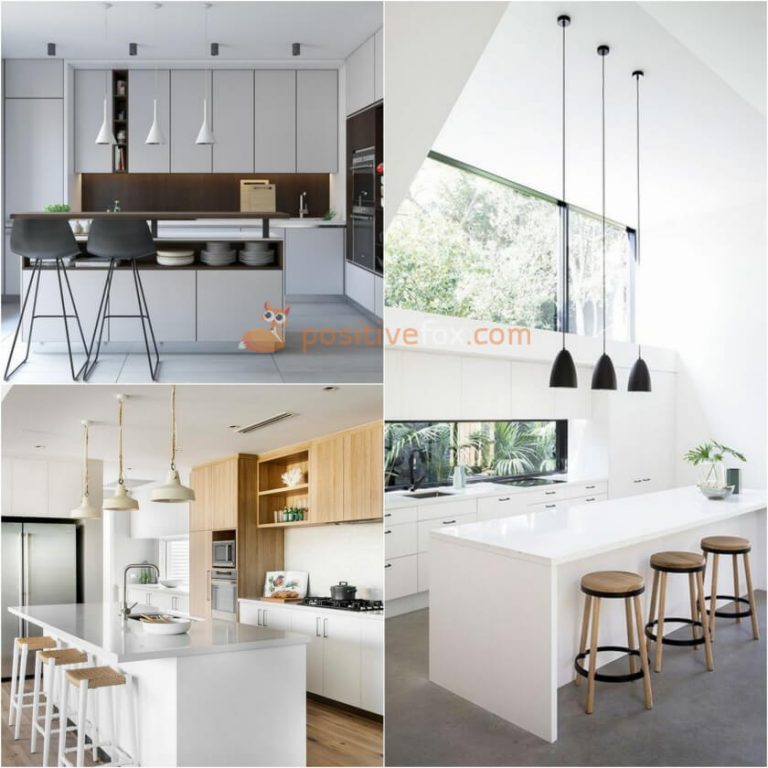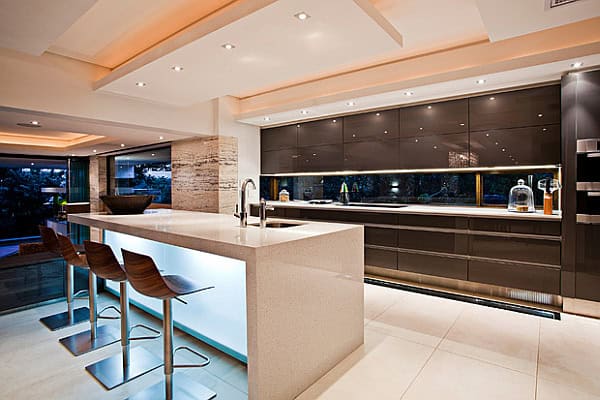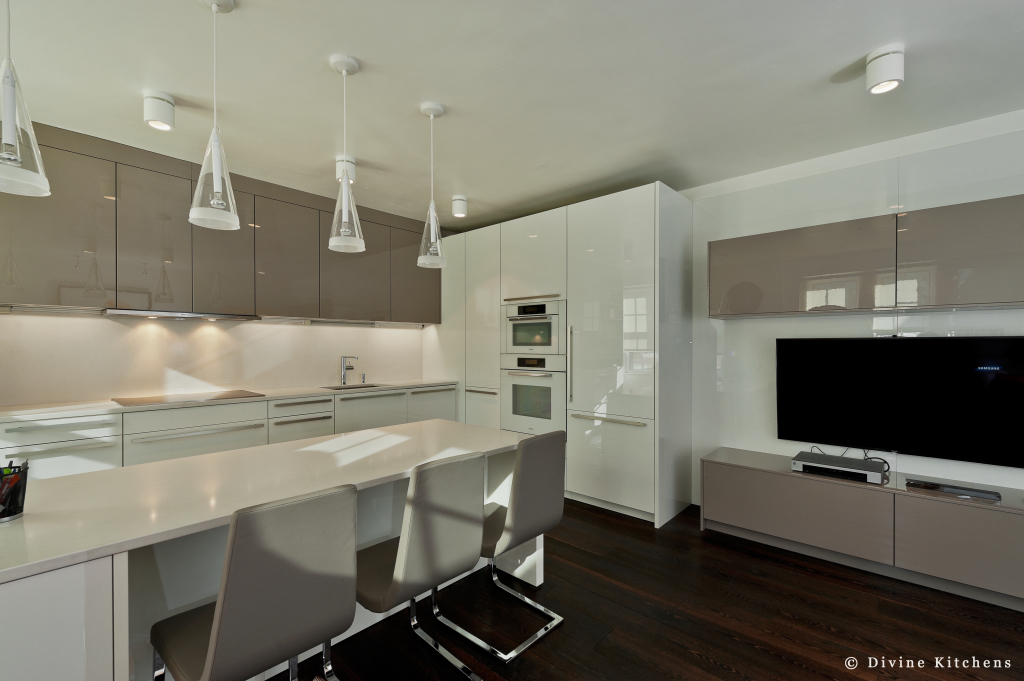Unconventional kitchen islands have become a hot trend in modern kitchen design, offering more than just a functional workspace. These unique islands can transform the look and feel of a kitchen, making it a standout feature in any home. Unlike traditional kitchen islands, which are often rectangular and utilitarian, unconventional kitchen islands break away from the norm with creative shapes, materials, and configurations. For example, a circular or oval island can create a more dynamic flow in the kitchen, allowing for easier movement around the space. Triangular or L-shaped islands can maximize corner spaces, providing additional countertop areas and storage without overcrowding the kitchen. The use of irregular or organic shapes can also add a sculptural element to the room, making the island a focal point that draws the eye.
One of the most popular trends in unconventional kitchen islands is the use of unique materials. While granite and quartz are common choices for countertops, an unconventional kitchen island might feature materials like concrete, reclaimed wood, or stainless steel. Concrete, for instance, can be molded into almost any shape and can be customized with various colors and textures. Reclaimed wood adds warmth and character to the kitchen, especially when paired with more modern elements like metal or glass. Stainless steel, often associated with professional kitchens, can give the island an industrial edge, while also being durable and easy to clean. These material choices not only set the island apart from the rest of the kitchen but also allow homeowners to express their style.

Another aspect of unconventional kitchen islands is their multifunctionality. In a small kitchen, where space is at a premium, an island that serves multiple purposes can be a game-changer. For instance, an island that combines a dining table with a prep area can eliminate the need for a separate dining space, making the kitchen more efficient. Some unconventional islands include built-in appliances, such as a cooktop, oven, or wine fridge, which allows the cook to stay engaged with guests while preparing meals. Others might incorporate open shelving or glass-fronted cabinets to display dishes and glassware, adding both storage and visual interest to the kitchen. The key to a successful multifunctional island is a thoughtful design that balances form and function.
In addition to their practical benefits, unconventional kitchen islands can also serve as a social hub in the home. By creating a space where people naturally gather, these islands encourage interaction and make the kitchen the heart of the home. For example, a large, curved island with seating on all sides can facilitate conversation among family members or guests, even while the cook is busy preparing food. In an open-concept floor plan, an island that extends into the living or dining area can help define the kitchen space while maintaining a sense of openness and connection with the rest of the home. This social aspect is especially important in homes where entertaining is a regular activity, as it allows the cook to be part of the action rather than isolated in the kitchen.

Lighting is another key consideration when designing an unconventional kitchen island. The right lighting can enhance the island’s functionality, highlight its unique features, and create a welcoming atmosphere. Pendant lights are a popular choice for kitchen islands, as they provide focused task lighting while also serving as a decorative element. For an unconventional island, consider using pendants in unexpected shapes, sizes, or materials, such as oversized drum shades, industrial-style metal fixtures, or hand-blown glass globes. Under-cabinet or under-counter lighting can also be used to illuminate the workspace and add a soft, ambient glow to the kitchen. In some cases, the island itself might incorporate lighting elements, such as LED strips embedded in the countertop or base, creating a dramatic, modern look.
Unconventional kitchen islands are not just about aesthetics; they also offer opportunities for innovation in kitchen design. For instance, some islands feature movable or retractable components, allowing the space to be adapted to different needs. A kitchen island with a retractable countertop, for example, can be extended to create additional prep space when needed, then retracted to free up floor space when not in use. Similarly, an island with a built-in, movable cutting board can be shifted to different areas of the countertop, providing flexibility for food preparation. This kind of adaptability is particularly useful in smaller kitchens, where space is limited and every square inch counts.

Sustainability is another important consideration in the design of unconventional kitchen islands. Many homeowners are now looking for ways to reduce their environmental impact, and the choice of materials and construction methods for the island can play a big role in this. For example, using reclaimed or locally sourced materials can reduce the carbon footprint associated with transportation and manufacturing. Similarly, choosing energy-efficient appliances and fixtures for the island can help reduce energy consumption in the kitchen. Some designers are even incorporating green features like herb gardens or composting stations into the island itself, making it a central part of an eco-friendly kitchen.
In terms of style, unconventional kitchen islands can range from rustic and traditional to sleek and ultra-modern. A farmhouse-style island, for example, might feature a distressed wood countertop, exposed beams, and vintage-inspired hardware, while a modern island might have a minimalist design with clean lines, glossy surfaces, and integrated technology. The choice of style will depend on the overall design of the kitchen and the homeowner’s personal taste. However, the beauty of an unconventional island is that it doesn’t have to conform to any particular style; it can be a unique, eclectic piece that reflects the personality of the homeowner and adds character to the kitchen.
One of the challenges of designing an unconventional kitchen island is ensuring that it fits seamlessly into the overall layout of the kitchen. Because these islands often feature unusual shapes or configurations, careful planning is required to make sure they don’t disrupt the flow of the space. For example, an island with an irregular shape might need to be placed at an angle to ensure that there is enough room to move around it comfortably. Similarly, an island that incorporates multiple functions, such as cooking, dining, and storage, must be designed in a way that allows these activities to coexist without interfering with one another. This often requires creative solutions, such as using different levels or zones within the island to separate different tasks.

Another consideration when designing an unconventional kitchen island is the choice of seating. While traditional bar stools are a common choice for kitchen islands, an unconventional island might call for something different. For example, a circular or curved island might be paired with swivel chairs that allow diners to turn and face different directions, while a low, extended island might be paired with bench seating for a more casual, communal dining experience. The choice of seating will depend on the height and shape of the island, as well as the intended use of the space. For example, an island that doubles as a dining table might require more comfortable, upholstered seating, while an island used primarily for food prep might benefit from simple, easy-to-clean stools.
Storage is another important aspect of kitchen island design, and unconventional islands often offer creative storage solutions that go beyond standard cabinets and drawers. For example, an island with open shelving can provide easy access to frequently used items, while also allowing for display of decorative pieces or cookbooks. An island with deep drawers can accommodate larger items like pots and pans, while a pull-out pantry can provide additional storage for dry goods. Some unconventional islands even incorporate hidden storage compartments, such as a pop-up appliance garage or a built-in knife block, which help keep the countertop clutter-free while maximizing storage space.
The integration of technology is another trend in unconventional kitchen islands. As kitchens become more connected, many homeowners are incorporating smart technology into their islands, such as touchless faucets, wireless charging stations, and built-in speakers. An island might also feature a smart cooktop with integrated controls, allowing the cook to adjust the temperature or settings without having to leave the prep area. This integration of technology can make the kitchen more efficient and convenient, while also adding a modern, high-tech feel to the space.
Finally, one of the most exciting aspects of designing an unconventional kitchen island is the opportunity to create a truly personalized space. Unlike standard kitchen islands, which are often mass-produced and uniform in design, an unconventional island can be custom-built to fit the specific needs and preferences of the homeowner. This might include unique features like a built-in pet feeding station, a pull-out ironing board, or a hidden bar. The possibilities are endless, and the result is a kitchen island that is not only functional but also a reflection of the homeowner’s lifestyle and personality.

Common Mistakes to Avoid:
When designing an unconventional kitchen island, it’s important to avoid some common mistakes. First, be careful not to choose a design that is too large for the space. An oversized island can dominate the kitchen, making it feel cramped and difficult to navigate. It’s important to measure the space carefully and ensure that there is enough room to move around the island comfortably.
Another mistake is neglecting the practical aspects of the island, such as storage and seating. While it’s tempting to focus on aesthetics, it’s important to remember that the island must also be functional. Be sure to include enough storage for kitchen essentials and seating that is comfortable and suitable for the intended use of the island.
Additionally, be mindful of the materials used in the island’s construction. While unconventional materials can add character and style, they must also be durable and easy to maintain. Finally, don’t overlook the importance of lighting. Proper lighting is essential for both task work and creating ambiance, so be sure to choose lighting fixtures that complement the island’s design while providing adequate illumination.

What are some unconventional materials I can use for my kitchen island?
Unconventional kitchen islands can be made from a variety of unique materials. Reclaimed wood adds warmth and character, while concrete offers a modern, industrial feel. Stainless steel is durable and easy to clean, making it a great choice for a professional-style kitchen. Other options include glass, which can be used for a sleek, modern look, and natural stone, such as soapstone or slate, for a more rustic appearance. The choice of material will depend on the overall design of the kitchen and the desired aesthetic.
How can I make my kitchen island multifunctional?
To create a multifunctional kitchen island, consider incorporating various elements that serve multiple purposes. For example, an island with a built-in cooktop or sink can streamline meal preparation, while a raised bar area can provide seating for casual dining. Open shelving or glass-fronted cabinets can add storage and display space, while also contributing to the island’s visual appeal. Some islands even include built-in appliances, such as a wine fridge or microwave, to maximize functionality in a small kitchen.
What are the benefits of an unconventional kitchen island?
An unconventional kitchen island can add personality and style to the kitchen, making it a standout feature in the home. It can also offer practical benefits, such as increased storage, additional countertop space, and enhanced functionality. By incorporating unique materials, shapes, and configurations, an unconventional island can create a more dynamic and interesting kitchen layout. Additionally, these islands often serve as a social hub, encouraging interaction and making the kitchen the heart of the home.

How do I choose the right lighting for my kitchen island?
When choosing lighting for your kitchen island, consider both function and aesthetics. Pendant lights are a popular choice, providing focused task lighting while also serving as a decorative element. For an unconventional island, consider using pendants in unique shapes, sizes, or materials, such as oversized drum shades or hand-blown glass globes. Under-cabinet or under-counter lighting can add ambient lighting and highlight the island’s unique features. It’s important to ensure that the lighting is adequate for the tasks performed on the island, such as food prep or dining.
What should I consider when designing the seating for my kitchen island?
The choice of seating for your kitchen island will depend on the height and shape of the island, as well as its intended use. For a casual dining experience, consider bench seating or upholstered chairs for added comfort. Swivel stools can be a good option for a curved or circular island, allowing diners to turn and face different directions. It’s important to ensure that the seating is comfortable and fits well within the overall design of the kitchen. Additionally, consider the height of the seating relative to the countertop, ensuring that there is enough legroom and that the seating is at the appropriate height for dining or working.
Can I design my unconventional kitchen island?
Yes, designing your unconventional kitchen island allows you to create a personalized space that fits your needs and style. Start by considering the layout of your kitchen and the functions you want the island to serve, such as food prep, dining, or storage. Then, choose materials and design elements that reflect your taste, whether it’s a rustic reclaimed wood countertop or a sleek, modern stainless steel base. It’s also important to think about the practical aspects, such as storage, seating, and lighting. If you’re not sure where to start, consulting with a kitchen designer can help you create a custom island that meets your needs and enhances the overall design of your kitchen.

Kitchen Island Costs How To Build A House

Irresistible Modern Kitchen Islands That Will Make You Say Wow

Our Work

When A Kitchen Island Doesn’t Work — Divine Design+Build

Related Posts:
- New Kitchen Island Ideas
- Kitchen Cabinet Island Design Pictures
- Taupe Kitchen Island
- Rustic Red Kitchen Island
- How Much Clearance Around Kitchen Island
- Flat Kitchen Island
- Eat In Kitchen Island Designs
- Decorating Kitchen Island For Christmas
- How To Build A Kitchen Island With Stove
- Painted Kitchen Island Images